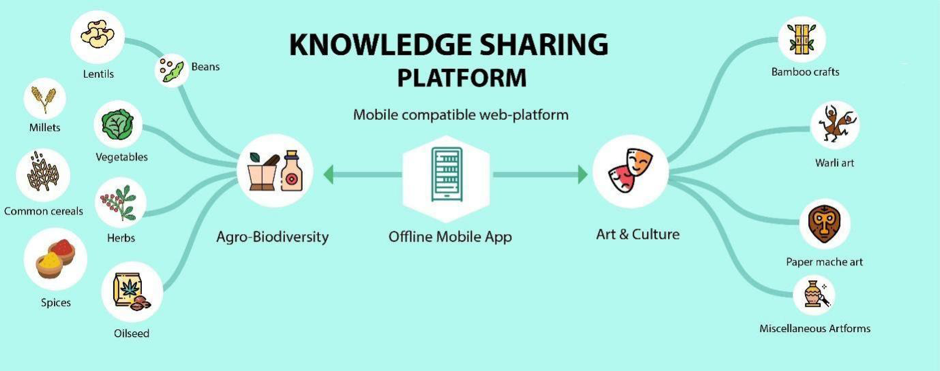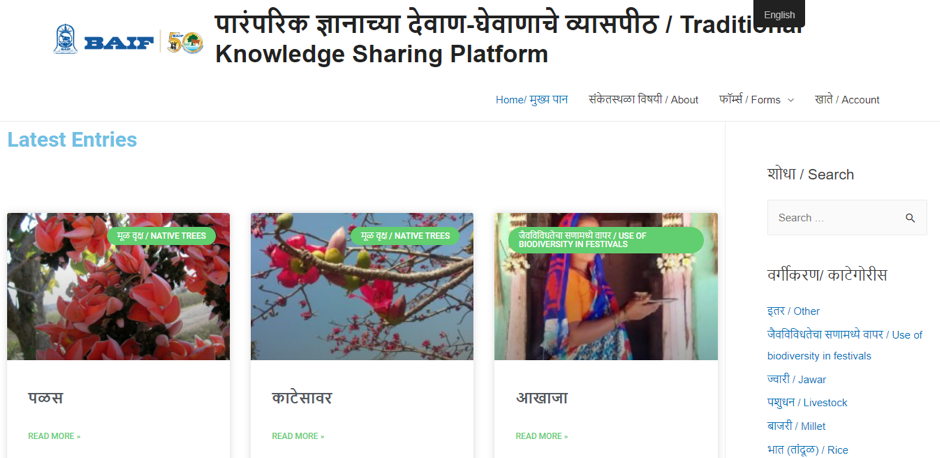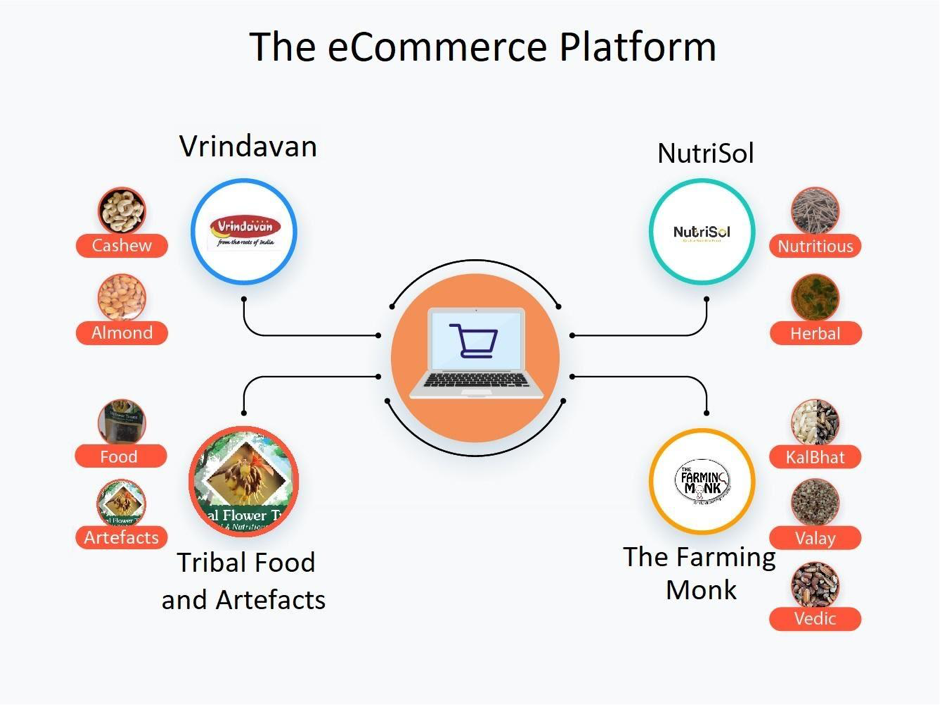India
| Attachment | Tamaño |
|---|---|
| English | 2.02 MB |
Organization
From ethno-biodiversity and cultural conservation to sustainability: Case study of the Aaple Pathardi community network[1]
Introduction
Over generations, tribal communities have developed and conserved Indigenous knowledge through hands-on practice in domains such as ethno-biodiversity and culture. This knowledge is mostly transferred through demonstration and has helped them in terms of nutrition, health, education, entertainment, and has been a support to navigate through difficult times. However, this knowledge is restricted within the community and often has no repository where the knowledge can be stored. Prevailing low levels of literacy do not allow this knowledge to be preserved in written form by the communities themselves (what we call “formal records” below). Because of this there is a need to document, conserve and exchange this knowledge, as it has a great significance for maintaining the ecological balance in communities and the regions where they are found.
Coping mechanisms based on Indigenous knowledge are particularly important for the most vulnerable people who have little access to formal employment, land or market opportunities. The work on conserving Indigenous knowledge on agro-biodiversity can, however, contribute towards climate justice and also demonstrate sustainability through the marketing of Indigenous products and know-how in a manner that meets the needs of the present without compromising the ability of the future generations to meet their own needs.
Based on this need, an open-source knowledge-sharing platform was created that enables traditional knowledge in the form of audio, video, photographs and text-based data to be shared among tribal communities. This web-based platform has been created as part of the Aaple Pathardi community network in Jawhar, India through a catalytic intervention grant funded by the Association for Progressive Communications (APC) Connecting the Unconnected project.[4]
The knowledge-sharing platform serves not only as a repository but also helps to promote the products resulting out of such knowledge through an e-commerce portal.
In the report we will be focusing on the journey of how traditional knowledge can be collected, organised and developed into products and eventually create livelihoods through the sale of local products made using Indigenous practices. The generation of livelihoods within the village helps decrease the distress of migration to cities in search of employment. It also can give economic sustainability to women in these communities and their families.
The knowledge-sharing platform that was developed offers greater insight into the relevance of ecosystem governance by Indigenous communities and how these can sustain and restore resilient landscapes. The platform also aids in building synergies between Indigenous knowledge and a universal scientific perspective which is a key link impacting environmental policies at multiple levels. In this way, biodiversity becomes a safety net to vulnerable households during times of environmental crisis and provides a reliable helping hand towards sustainable opportunities.
Background
Globally, there is a constant struggle by Indigenous communities to reclaim their right over land and to preserve their knowledge and culture. Indigenous knowledge forms the crux of every society and is one of the crucial components that define the cultural capital of these communities ranging from music, dance, art forms, indigenous seeds, herbal medicine, farming practices and conservation of seeds, among many others.
Indigenous knowledge refers to the knowledge and know-how that is unique to a given society or community which encompasses "the cultural traditions, values, beliefs and worldviews of local people."[5] It comprises a complete knowledge system of its own, based on traditional Indigenous culture and knowledge systems focused on practicality and dynamicity. Indigenous knowledge thus on one hand offers strict parameters for community interaction, and on the other is fluid in nature, enabling a constant renegotiation with the environment in which these communities are located. It is often transferred from one generation to the next, primarily by replication and repetition.[6] Tracing this type of knowledge also enables a good understanding of the development process of societies and how this knowledge has been sustained socially, culturally and economically.
Indigenous knowledge is deeply rooted in a community’s relationship to the environment, and in this way helps in the sustainable use and management of natural resources. Rapid technological advancements, globalisation and social change have begun showing the slow depletion of Indigenous knowledge and adoption of different ways of living. The knowledge in some cases is challenged by scientific information, as well as knowledge dominated by a worldwide opinion. This has presented a lot of challenges for Indigenous knowledge to thrive and be sustained. There is a need for such knowledge to be documented, accessed, shared and disseminated, and in this way be preserved.
The dominating use of information and communications technologies (ICTs), including smart phone proliferation, has enhanced the preservation process of Indigenous knowledge. Amidst this ease of access to technology, existing barriers to internet connectivity in remote rural areas disadvantage unconnected Indigenous communities and the potential for them to share their Indigenous knowledge. Internet connectivity is still a distant dream for the almost 60% of rural India that is unconnected. In most of the cases, enabling connectivity to such areas is challenging due to a variety of reasons, such as lack of cost-effective technology solutions, deployments that are not robust, arduous terrain conditions, the unavailability of backhaul/tower infrastructure and a lack of sustainable business models. Because of this there is a need for not only technological innovation but also the development of innovative solutions for end-to-end rural connectivity.
In order for connectivity to reach these remote locations, there is a need for both middle-mile technology innovation as well as the development of innovative solutions like community networks for last-mile connectivity. Seeding the growth of community networks is one innovative solution that helps to achieve the goal of connectivity reaching remote areas, and also ensures the sustainability of the connectivity.[7] At the same time that connectivity is enabled, community networks also allow the community to utilise the connectivity in a meaningful way to enhance their own livelihoods.
In this report, we showcase how a community network was seeded to grow in the remote village of Pathardi in Maharashtra, India. The report also explains how Indigenous knowledge related to the community is collected and saved in a shared repository by the community. In addition to these, the report emphasises how this Indigenous knowledge can enable livelihood options for the community, fulfilling the need to preserve the knowledge as well as aid environmental sustainability.
The platforms bridging generations: A traditional knowledge-sharing and e-commerce platform
There is an Indigenous knowledge heritage within tribal communities in India who have lived through generations without any recorded knowledge transfer. This knowledge is transferred through storytelling and practice. The younger generations of these tribal communities have started interfacing with the modern world and are now exposed to formalised methods of learning. As the younger generation engages more and more with the established scheme of standardised education, their involvement with the traditional knowledge practices has reduced over time. As a result, there is now a situation wherein if the traditional knowledge of tribal communities is not documented and converted into formalised systems using modern technologies, the younger generations of these communities are at a significant risk of losing the know-how of these practices.
With this background, a traditional knowledge-sharing platform was conceived for sharing ethno-biodiversity and cultural practices of tribal communities by BAIF Development Research Foundation. This work was funded through an APC catalytic intervention grant and was initially proposed as a pilot initiative by a community network that had been set up in the remote Pathardi community. The plan is to gradually build the database to include Indigenous knowledge from various communities across the state of Maharashtra and possibly beyond (see Figure 1).

Figure 1: The schematic of the knowledge-sharing platform
The platform currently caters primarily for ethno-biodiversity. However, cultural knowledge is also to be added to its portfolio. During the development of the platform, a number of open-source options were scouted and WordPress was chosen, considering its popularity and user-friendly features. Even as the platform was being built, an offline mobile-based mechanism to collect data from the field was thought of. In this context, Epicollect5, an intuitive free offline mobile-based data collection app was chosen. The questionnaire that was used to collect the information was translated into the regional language of Marathi and uploaded as a form in the Epicollect5 Android app.
The community resource persons (CRPs) selected from the community were guided to undertake the mobile-based data collection from the field using Epicollect5. The CRPs visited the fields and homes of the village community to collect the data, and aggregated several entries covering rice, millet, lentils and other crops in the Pathardi community network. These entries included text, image and geolocation information. This information was then downloaded as spreadsheets and individual image files. These were then uploaded on the WordPress platform configured to our requirements using a plug-in. Now all these entries are available on the platform (see Figure 2).[8]

Figure 2: A screenshot of the traditional knowledge-sharing platform (https://ksp.baif.org.in)
Categories such as “rice”, “millets”, “Jawhar”, “native trees”, “livestock”, “use of biodiversity in festivals” and “other” have been populated on the platform. Forms to upload entries into other categories such as folk music are also available.
While all the above interventions mentioned seem more concerned with documentation, for any tradition to continue to live, it needs to be actively archived. However, any such pursuit would probably only be sustainable when a positive impact of this work can be felt in the community, sometimes in economic terms. This is possible only if the traditional knowledge is able to meet the needs of parts of the community, for example, through value-added services or products.
Keeping this in mind, the development of an e-commerce platform[9] was also envisaged. The development of this platform was also funded by the APC catalytic intervention grants. Some of the rice and millet varieties documented in the Jawhar area of Maharashtra as part of the knowledge-sharing platform have now been selected and packaged under the brand “The Farming Monk” and are being sold as part of a farmer producer company, Vasundhara Agri-Horti Producer Company Limited (VAPCOL), which manages the e-commerce platform. Apart from these offerings, processed mango, cashew and gooseberry-based products such as pickles, preserves and flavoured dry fruits are also available through the brand name of Vrindavan. Other products such as tribal food, arts and crafts, nutritious herbal food (Sankalp) and bamboo-based jewellery (Baansuli) are planned to be sold through the platform (Figure 3).

Figure 3: The schematic of the e-commerce platform
Apart from these products, several photos of traditional art forms such as Warli art have been documented. A video on the traditional Bohada festival of paper maché art[10] was also undertaken. In addition, an augmented reality Android app called Warli was developed, where the person using the app can see how he/she would look wearing a paper maché mask. It is planned that the e-commerce portal would initially cater for the discerning consumers in Pune. However, based on tie-ups with e‑commerce logistics partners, offering deliveries in other places in the country will be explored. This platform does not aim to compete with large existing e‑commerce platforms; it only tries to offer an option for value-added sales of the products made by communities which are conserving traditional agro-biodiversity and art forms (Figure 4).
 Figure 4: A screenshot of the e-commerce platform (https://vapcol.com)
Figure 4: A screenshot of the e-commerce platform (https://vapcol.com)
Conclusion
In the project described above, the involvement of the community is a defining characteristic of preserving Indigenous knowledge within the community. The project benefited from the expertise and participation of the community. The project grant from APC was made available to help understand in greater detail the potential role that community networks can play in connecting the unconnected. Through the implementation of this project, we understood that one of the needs of the local community was to preserve their Indigenous knowledge in various forms like audio, video, photographs, etc. The project also made it clear that community networks can be successful when they have a strong understanding of community needs and expectations, seek the active involvement and participation of the community, and respect the knowledge which is shared by the community.
The project has also substantially catered to the livelihoods of the people in the community by selling the products on the e-commerce platform. There has additionally been a positive impact on environmental sustainability through the information made available in the biodiversity database.
Community needs have been adhered to in this project by using the offline version of the data collection application that ensures the information can still be collected when people are offline, and uploaded later to the online space. This means that the project has adopted technology that is easy to use. Although not discussed above, it has also trained youth in the village (called “eDosts”) who collect the information, adding to the reliability of information that is captured. In the near future, the platform, which is flexible, will be customised to accommodate the future requirements of the community. This model of a traditional knowledge-sharing platform and an e-commerce platform is context-specific, yet it is probably replicable and sustainable. It connects the traditional with the modern, the earlier generation with the next generation.
Action steps
Traditional knowledge preservation is an important aspect of community networks and, as in the project described, can showcase a good use case of meaningful internet connectivity. As community networks are networks for and by the community, building local repositories of Indigenous knowledge can be a very fruitful contribution. Indigenous knowledge is inherited through oral, visual and mostly in an experiential manner, and is a challenge to document in its entirety. However, in this project, a beginning has been made in terms of capturing the Indigenous knowledge through photographs, songs, demonstrations, conversations, practices and community pursuits. However, there could be many more ways to document experiential ways of living and working, including using virtual or augmented reality that could allow a deeper interaction with community practices.
Further, the combination of a mindful community with a thriving biodiversity and cultural ecosystem with a supporting digital infrastructure can probably bring together the synthesis of age-old practices with modern platforms to enable a new and eternally evolving knowledge form. The biodiversity knowledge platform is a good way of aggregating the traditional knowledge of the environment and farming practices of the Indigenous people, even helping them know their forests and natural resources much better. Such a type of knowledge aggregation also helps in promoting the sustainable management of forests by supporting afforestation and reforestation programmes through awareness raising. In a context where Indigenous communities are facing threats from agricultural modernisation, a biodiversity platform like this has a positive impact on the role of indigenous seed crops, and builds agricultural resilience by promoting preservation. Linking biodiversity conservation and local people's livelihoods is a sustainable way of addressing the need for the preservation of biodiversity among Indigenous communities.
Footnotes
[1] We would like to thank the following teams for their active support: Association for Progressive Communications (APC) for seed funding for the initiative in Pathardi, Maharashtra, India; the Maharashtra Gene Bank (MGB) Project team and Servelots team for their involvement and contributions in developing the traditional knowledge-sharing platform; the VAPCOL team for developing and managing the e-commerce portal; and the Integrated Village Development Project (IVDP) team for helping combine synergies at the Pathardi community.
[2] Asia regional coordinator, local access and community networks project, Association for Progressive Communications (APC); senior research scientist, Spoken Tutorial project, Indian Institute of Technology Bombay, Mumbai, India; IEEE InDITA Chair for Accessibility and Affordability.
[3] Programme manager, ICT Team, BAIF Development Research Foundation, Pune, India.
[4] https://www.apc.org/en/node/35859
[5] Agrawal, A. (1995). Dismantling the divide between indigenous and scientific knowledge. Development and Change, 26(3), 413-439.
[6] Tom, M. N., Sumida Huaman, E., & McCarty, T. L. (2019). Indigenous knowledges as vital contributions to sustainability. International Review of Education, 65, 1-18. https://doi.org/10.1007/s11159-019-09770-9
[7] Belur, S. B. (2018). Addressing sustainability in rural connectivity: A case study of Gram Marg community-led networks. In A. Finlay (Ed.), Global Information Society Watch 2018: Community Networks. APC & IDRC. https://www.giswatch.org/en/country-report/infrastructure/india-0; Belur, S. B, Khaturia, M., & Rao, N. P. (2017). Community-led networks for sustainable rural broadband in India: The case of Gram Marg. In L. Belli (Ed.), Community Networks: The internet by the people, for the people. Official 2017 Outcome of the UN Internet Governance Forum (IGF) Dynamic Coalition on Community Connectivity (DC3). http://bibliotecadigital.fgv.br/dspace/handle/10438/19401
[10] https://youtu.be/TqDPp_BN34s
Notes:
This report was originally published as part of a larger compilation: “Global Information Society Watch 2020: Technology, the environment and a sustainable world: Responses from the global South"
Creative Commons Attribution 4.0 International (CC BY 4.0) - Some rights reserved.
ISBN 978-92-95113-40-4
APC Serial: APC-202104-CIPP-R-EN-DIGITAL-330
ISBN 978-92-95113-41-1
APC Serial: APC-202104-CIPP-R-EN-P-331